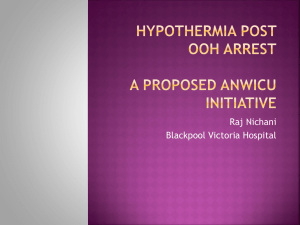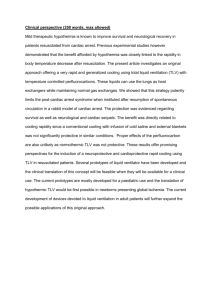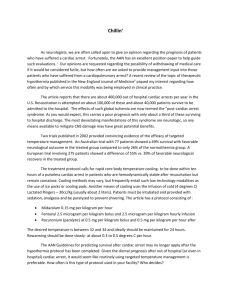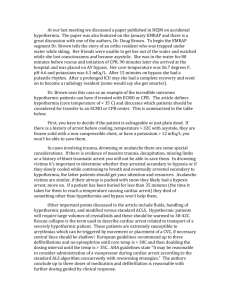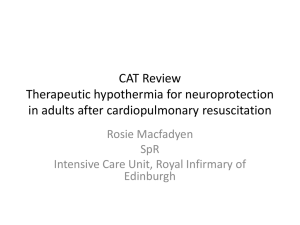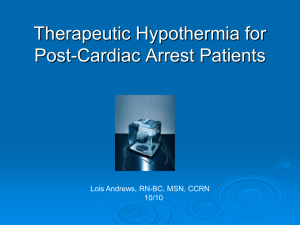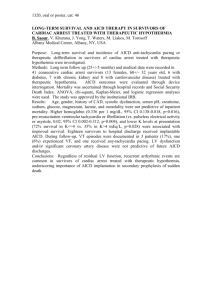Community Memorial Health Hypothermia Policy
advertisement
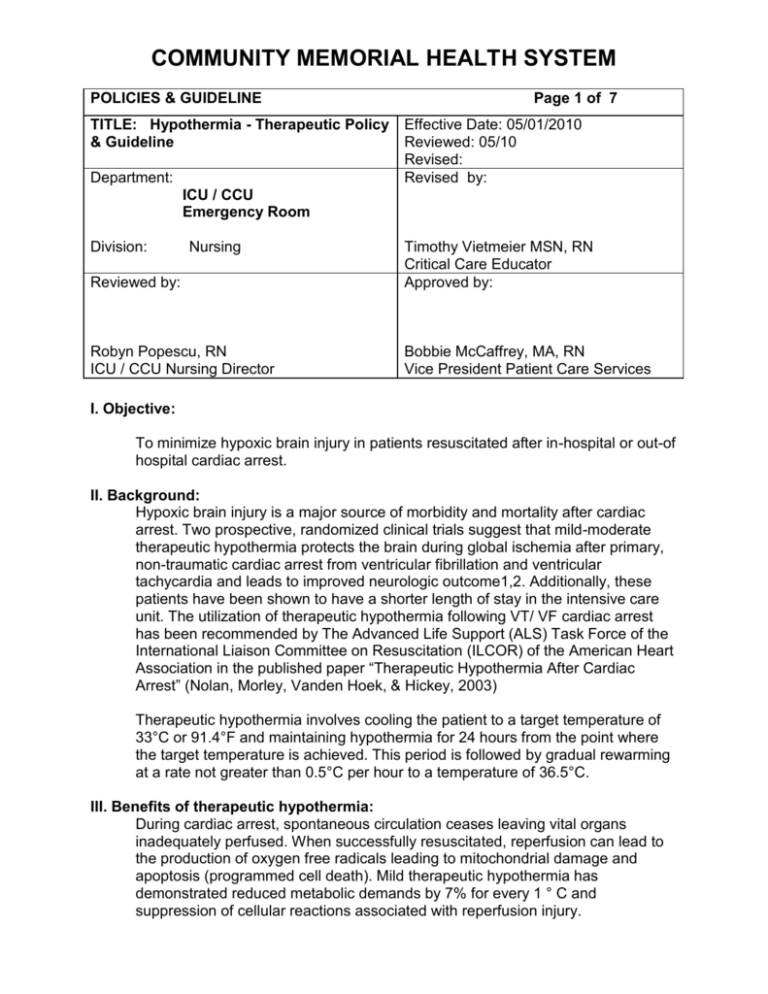
COMMUNITY MEMORIAL HEALTH SYSTEM POLICIES & GUIDELINE Page 1 of 7 TITLE: Hypothermia - Therapeutic Policy Effective Date: 05/01/2010 & Guideline Reviewed: 05/10 Revised: Department: Revised by: ICU / CCU Emergency Room Division: Nursing Reviewed by: Timothy Vietmeier MSN, RN Critical Care Educator Approved by: Robyn Popescu, RN ICU / CCU Nursing Director Bobbie McCaffrey, MA, RN Vice President Patient Care Services I. Objective: To minimize hypoxic brain injury in patients resuscitated after in-hospital or out-of hospital cardiac arrest. II. Background: Hypoxic brain injury is a major source of morbidity and mortality after cardiac arrest. Two prospective, randomized clinical trials suggest that mild-moderate therapeutic hypothermia protects the brain during global ischemia after primary, non-traumatic cardiac arrest from ventricular fibrillation and ventricular tachycardia and leads to improved neurologic outcome1,2. Additionally, these patients have been shown to have a shorter length of stay in the intensive care unit. The utilization of therapeutic hypothermia following VT/ VF cardiac arrest has been recommended by The Advanced Life Support (ALS) Task Force of the International Liaison Committee on Resuscitation (ILCOR) of the American Heart Association in the published paper “Therapeutic Hypothermia After Cardiac Arrest” (Nolan, Morley, Vanden Hoek, & Hickey, 2003) Therapeutic hypothermia involves cooling the patient to a target temperature of 33°C or 91.4°F and maintaining hypothermia for 24 hours from the point where the target temperature is achieved. This period is followed by gradual rewarming at a rate not greater than 0.5°C per hour to a temperature of 36.5°C. III. Benefits of therapeutic hypothermia: During cardiac arrest, spontaneous circulation ceases leaving vital organs inadequately perfused. When successfully resuscitated, reperfusion can lead to the production of oxygen free radicals leading to mitochondrial damage and apoptosis (programmed cell death). Mild therapeutic hypothermia has demonstrated reduced metabolic demands by 7% for every 1 ° C and suppression of cellular reactions associated with reperfusion injury. POLICY & PROCEDURE Page 2 of 7 Sudden cardiac arrest is a major cause of morbidity and mortality. Survivors frequently have significant neurologic damage caused by cerebral edema and ischemia following the cardiac arrest. Recent studies have indicated that therapeutically induced mild hypothermia in patients who have suffered cardiac arrest with return of spontaneous circulation (ROSC) has been associated with improved functional recovery and reduced cerebral histological deficits. (Nolan, Morley, Vanden Hoek, & Hickey, 2003) IV. Indications: 1. Comatose adult patients resuscitated after cardiac arrest from ventricular fibrillation, ventricular tachycardia, pulse less electrical activity (PEA) or asystole, remaining unresponsive without contraindications to mild hypothermia. 2. Therapeutic hypothermia after pulseless electrical activity (PEA) or asystole should be strongly considered unless absolute or relative contraindications are present since neurologic injury is a major source of morbidity and mortality after cardiac arrest of any cause. 3. Inclusion criteria A. Patients who have been shown to benefit from induced hypothermia include the following: a. Pulseless VT/ VF cardiac arrest with restoration of spontaneous circulation b. Consider use in pulseless electrical activity (PEA) or Asystole. c. Endotracheal intubation with mechanical ventilation d. Treatment initiated within a 6-hour post cardiac arrest time window e. Those able to maintain a systolic blood pressure >90 mm Hg and/ or a MAP >60 mm Hg, with or without pressors, after cardiopulmonary resuscitation (CPR) f. Those in a coma at the time of cooling. g. Coma is defined as not following commands. h. Brainstem reflexes and pathological/posturing movements are permissible. i. Patients with a Glasgow Coma Score (GCS) of 3 are eligible for hypothermia. j. Age greater than 18 years. k. Women of childbearing age must have a negative pregnancy test (must be documented on the chart) V. Contraindications 1. Absolute Exclusion Criteria:: A. Patient is awake and responsive B. Patients with a known bleeding diathesis or with active ongoing bleeding C. Acute trauma, intracranial pathology, or major head trauma D. Systemic infection/sepsis a. Hypothermia may inhibit immune function and is associated with a small increase in risk of infection. E. Recent bum with skin that is not intact F. Pre-existing persistent vegetative state & Minimal pre-morbid cognitive status G. Pregnancy POLICY & PROCEDURE Page 3 of 7 2. Relative Exclusion Criteria: A. Patients with a valid do not resuscitate order (DNR) B. > 6 hours since the return of spontaneous circulation (ROSC) a. Data suggest cooling patients as soon as possible post-cardiac arrest C. Temperature of < 30° C after cardiac arrest D. Persistent hypotension with MAP < 60 mmHg E. Cardiovascular instability with uncontrolled arrhythmias F. Recent major surgery (intrathoracic or abdominal) within 14 days a. Hypothermia may increase the risk of infection and bleeding. G. Active infection H. Patients in a coma from other causes (drug intoxication, preexisting coma prior to arrest) I. Chronic renal failure VI. Policy & Guideline 1. Induction of cooling: A. Initiate cooling as quickly as possible after return of spontaneous circulation if patient does not awaken and follow commands. B. CT scans and cardiac catheterization can be performed concurrently with cooling. C. Place the surface cooling device in the Emergency Department if resuscitated out of-hospital or in the Intensive Care Unit after an in-hospital arrest. Set the temperature goal at 33°C for a total of24 hours. D. The surface cooling devices are stored in the Emergency Department & Intensive Care Unit. E. Place an esophageal or urinary/bladder temperature sensor and connect to the surface cooling device temperature cable F. Cooling blankets and ice packs can be used if the surface cooling device is in use. G. Special care must be taken not to overshoot the temperature as there are serious side effects. 6 H. Administer midazolam or propofol and ensure adequate sedation per order 2. Treatment of shivering: A. Shivering is the body's response to maintain homeostasis and produce heat. In turn, it increases oxygen consumption by 40-100%. B. Document the observation of shivering by utilizing the shiver scale in the order set. C. Administer Fentanyl per order to suppress shivering D. If sedation and Fentanyl fails to suppress shivering administer neuromuscular blockade per order. E. Neuromuscular blockade (Cisatracurium or Vecuronium) is used per order to prevent shivering. Train-of-four (TOF) monitoring is not reliable with mild to moderate hypothermia due to slowed nerve conduction from the cooling. Discontinue neuromuscular blocking medications once the patient reaches the goal temperature of 33°C. F. For recurrence of shivering once the goal temperature has been reached, rebolus with midazolam or Fentanyl per the therapeutic hypothermia orders. If POLICY & PROCEDURE Page 4 of 7 there are continued signs of shivering, the physician should be notified for additional orders. 3. Cooling Procedure: A. Obtain initial labs per physician order B. Apply continuous temperature monitoring C. VS every 15 minutes, with particular attention to arrhythmia detection until desired temperature obtained, then every 1 hr D. Urine output every hour E. Assess skin for burns caused by ice/cooling blankets every two hours F. Keep Head of Bed (HOB) greater than 30 degrees at all times G. Turn off ventilator heating unit H. Ensure patient is adequately sedated per physician order I. Monitor patient and follow orders for treatment of shivering. J. Use Ophthalmic Lubricant Ointment as ordered to prevent corneal damage. K. The patient’s target temperature is 33°C, but many patients hover between 33°C – 33.5°C. Cooling should be maintained for 24 hours from the point at which the patient’s core body temperature remains consistently below 34°C. 4. External cooling A. Eligibility confirmed, materials gathered, patient sedated per physicians orders B. Initiate cooling with Blanketrol III and Cooling Kit (Head wrap, Patient Vest, Lower Bed Blanket) a. Adjust target temperature to 33°C (91.4° F) C. Infuse chilled intravenous normal saline via peripheral line or femoral venous per physicians order at 4° C if no evidence of Pulmonary Edema a. This helps drop the core temperature b. Stop infusion and notify physician if Sa02 < 90% c. Do Not infuse chilled NaCl through a jugular or subclavian line Since the exit port is close to the heart there is fear of cardiac dysrhythmias or standstill. d. Do not exceed 2 liters D. Apply ice packs to axilla, neck and groin regions using sheets, towels, or pillowcases to protect patient’s skin to bring patient to goal temperature. a. Avoid packing ice on top of chest; that may impair chest wall motion. b. Once goal temperature is reached, ice bags may be removed and the cooling blankets used to maintain temperature. E. Assess for shivering and document hourly 0 0= no shivering 1= one or more of the following: piloerection, peripheral cyanosis 1 without other cause; without visible muscular activity 2 2= visible muscular activity confined to one muscle group 3 3= visible muscular activity in more than one muscle group 4 4= gross muscular activity involving the entire body F. Note: Call physician for a score of 2 or more for greater than 5 minutes despite deep sedation POLICY & PROCEDURE Page 5 of 7 5. Complications of cooling: A. Arrhythmias: Continuous ECG is required. Bradycardia is a frequent observation. Do not treat unless the patient is symptomatic. B. Blood glucose monitoring should be performed every 4 hours or as ordered. a. Due to the stress on the body from cardiac arrest and from being placed in hypothermia, blood sugars can fluctuate. The goal is to avoid blood glucoses < 60 or > 200. b. Insulin should be given IV. Medication absorption is reduced in a hypothermic state. C. Infection: Implement ventilator associated pneumonia (V AP) precautions. a. Cooling may mask signs of infection. D. Coagulopathy: Monitor PTT, PT/INR & platelet count ifthere is suspicion of bleeding. E. Electrolyte imbalance: Electrolytes shift into the cell during the cooling phase, leaving low serum potassium & magnesium levels. Replace electrolytes to maintain: magnesium level >/= 2.0, potassium level >/= 4.0 F. Potassium should be monitored every 4 hours or as ordered. a. Due to the stress on the body from cardiac arrest, tissue damage and/ or death, and from being placed in hypothermia, potassium can fluctuate. b. Severe hypokalemia may be seen in hypothermic patients, which represents a shift of potassium rather than a true loss. Careful management of this electrolyte problem is necessary to avoid hyperkalemia with rewarming. c. You should consider measuring serum K+ prior to rewarming and hold all K+ containing fluids if K+ > 3.5 immediately before and during rewarming 6. The physician should be notified of: A. Hypotension (systolic <90 mm Hg or MAP < 60 mm Hg) B. Oliguria C. Cardiac arrhythmias D. Decerebrate/decorticate posturing E. Developing anisocoria (difference in pupil size) F. Seizure activity 7. Maintenance of cooling: A. Cooling should be maintained for 24 hours from the point at which the patient’s core body temperature remains consistently below 34°C. B. Labs: CBC, TPN Panel, CPK, Troponin, ABG once the goal temperature has been reached, then every 6 hours thereafter. C. Hyperglycemia: Consider the “Insulin Infusion Protocol“ to prevent hyperglycemia. The target blood glucose is 140-180. D. Maintain sedation with a midazolam or propofol infusion and administer boluses as necessary unless otherwise ordered. POLICY & PROCEDURE Page 6 of 7 8. Controlled re-warming: A. Begin the re-warming process after a total of 24 hours on the cooling protocol utilizing the surface cooling device. B. Program the surface cooling device to re-warm to 0.25°C per hour over 12 to 14 hours. If re-warming is done too quickly, there may be activation of a systemic inflammatory response. a. When patient is rewarmed to ≥ 36.5°C (97.7° F) thermal blankets can be removed C. Turn on ventilator heating unit once temp > 36.5°C D. Monitor temperature and vital signs every 15 min during rewarming procedure E. Monitor for hypotension which may be a result of peripheral vasodilation. a. Consider IV fluids for treatment of hypotension. F. Measure and record urine output every hour G. Continue skin assessment for tissue injury that occurred during the cooling and warming process H. Stop NMB infusion after core temperature reaches 36° C I. Monitor electrolyte levels every 6 hours. Electrolytes will shift back into the serum during the re-warming phase. Hold electrolyte replacement during the rewarming phase. a. If potassium or magnesium levels are low during the re-warming phase, call the physician (Careful consideration should be taken when replacing electrolytes during the re-warming phase due to cellular electrolyte shifts). J. Continue the midazolam or propofol infusion through the re-warming phase. K. If shivering is evidenced during the re-warming phase, administer Fentenyl per order. If Fentanyl fails to resolve the shivering call the physician and consider Cisatracurium or Vecuronium. Once the temperature reaches 35°C, utilize the peripheral nerve stimulator and titrate to 1-2 out of 4 twitches. L. Avoid rebound hyperthermia and Notify physician of temperature > 38°C (100.5° F) VII. Other notes: 1. Discontinue the cooling protocol if the patient awakens and follows commands. 2. Cooling should not be interrupted to perform a neurological examination. 3. Patients may receive cardiac interventions including percutaneous coronary intervention (PCI), anticoagulation and systemic thrombolysis if clinically indicated while on the cooling protocol. 4. Patients with intra-aortic balloon therapy can be safely cooled.7 5. Signs and symptoms of hypotension during rewarming can lead to a poor outcome for the patient and need to be evaluated. The physician may consider ending the therapeutic hypothermia based on these findings. A. Fluids should be considered first, unless the patient is in CHF. a. If the fluid orders fail to increase the systolic BP ≥ 80 or a MAP greater than 70; or if the patient is in heart failure or becoming septic, speak to the physician about inotropes and vasopressors to support the blood pressure. 6. All patients should be on DVT Prophylaxis and GI Prophylaxis unless contraindicated or ordered by the physician. A. If the physician has ordered DVT Prophylaxis or GI Prophylaxis to be stopped, a reason must be documented POLICY & PROCEDURE Page 7 of 7 References 1.Bernard, S. A., Gray, T. W., Buist, M. D., Jones, B. M., Silvester, W., Gutteridge, G., & Smith, K. (2002). Treatment of comatose survivors of out-of-hospital cardiac arrest with induced hypothermia. The New England Journal of Medicine, 346(8), 557-563. 2.Hypothermia after Cardiac Arrest Study Group. (2002). Mild therapeutic hypothermia to improve the neurologic outcome after cardiac arrest. The New England Journal of Medicine, 346(8), 549-556. 3.Brauner, M. E., & Sayre, M. R. (2008, December). Therapeutic Hypothermia. In eMedicine.eMedicine. Retrieved October 22, 2009, from eMedicine: http://emedicine.medscape.com/article/812407-overview 4.Felberg, R. A., Krieger, D. W., Chuang, R., Persse, D. E., Burgin, W. S., Hickenbottom, S. L., Morgenstern, L. B., Rosales, O., & Grotta, J. C. (2001). Hypothermia after cardiac arrest: feasibility and safety of an external cooling protocol. Circulation, 104(15), 1799-1804. 5.Hammer, L., Vitrat, F., Savary, D., Debaty, G., Santre, C., Durand, M., Dessertaine, G., & Timsit, J. F. (2009). Immediate prehospital hypothermia protocol in comatose survivors of out-of-hospital cardiac arrest. American Journal of Emergency Medicine, 27(5), 570573. 6.Nolan, J. P., FRCA, Morley, P. T., MD, Vanden Hoek, T. L., MD, & Hickey, R. W., MD. (2003). Therapeutic Hypothermia After Cardiac Arrest: ILCOR Advisory Statement. Circulation, 108, 118-121. 7.Oddo, M., Ribordy, V., Feihl, F., Rossetti, A. O., Schaller, M. D., Chioléro, R., & Liaudet, L. (2008). Early predictors of outcome in comatose survivors of ventricular fibrillation and non-ventricular fibrillation cardiac arrest treated with hypothermia: a prospective study. Critical Care Medicine, 36(8), 2296-2301. Storm, C., Steffen, I., Schefold, J. C., Krueger, A., Oppert, M., Jörres, A., & Hasper, D. (2008). Mild therapeutic hypothermia shortens intensive care unit stay of survivors after out-ofhospital cardiac arrest compared to historical controls. Critical Care, 12(3), R78.
